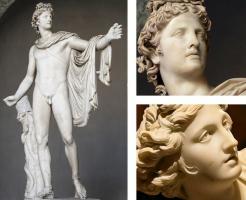The Mona Lisa or La Gioconda: meaning and analysis of the painting
The Mona Lisa, also known as The Mona Lisa, is a Renaissance work painted by multi-faceted artist Leonardo da Vinci. The painting was painted between 1503 and 1506 and, today, it is one of the most important symbols of Western culture. It is currently in the Louvre Museum in Paris, France.
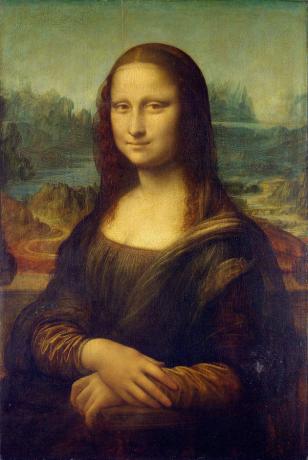
The Mona Lisa It is considered the most famous painting in the world. Few works have passed through so much scrutiny and study. Some of the reasons that make it so famous are:
- Leonardo da Vinci's extreme realism in using mathematical methods to measure human proportions,
- The unique technique of sfumato which also conveys a very advanced realism for the time,
- The revolution that it generated in the dimensions and in the ways of portraying, considered the basis of all western portraits,
- The sum of the mysteries of painting; from the identity of the model to why Leonardo da Vinci never delivered the commission.
Analysis of the Mona Lisa
The Mona Lisa It is a work that belongs to the genre of pictorial portraiture. This genre was promoted in the Renaissance and can be considered a true revolution, since it openly expresses the anthropocentric interest of that period. Now, what are the compositional characteristics of the famous painting?
Description and characteristics
From the point of view of composition, the Mona Lisa It is a half-length or three-quarter portrait of a landscape that is divided into two atmospheres, one colder (the upper one) and the other warmer with earthy colors (the lower one).
The woman's posture derives from the "pyramid" used to represent women. madonnas seated, that is, it is a triangular geometrization.
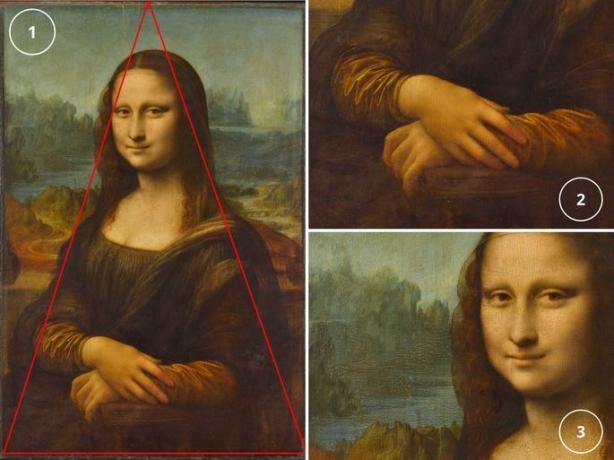
Their crossed hands form the base of the pyramid shape. The light applied to the chest and neck is the same applied to the hands.
The center of the square is the woman's chest and is aligned with the left eye and fingers of her right hand. This accentuates the presence of the character in the composition.
Her left arm is comfortably supported on the arm of the chair and is crossed by her right arm. The position of her arms together with that of her armchair transmit a distance between her and the viewer.
Her head is covered by a veil symbolizing chastity, frequent in portraits of a wife. The use of this type of veil is also attributed to pregnant or postpartum women. She does not present jewels or particular signs of economic ostentation or power.
The posture of the Mona Lisa It indicates serenity and, together with the sidelong gaze, but direct towards the viewer, shows the mastery of feelings, something that was not normally attributed to a woman at that time.
Her face has no eyebrows. The expression of the woman in the painting is enigmatic or ambiguous. This is because the gaze, the body and the hands are directed at subtly different angles, added to the illusion that the technique of the sfumato.
At the left edge of the painting you can see the base of a column, hinting that the woman is sitting in a gallery.
The landscape in the background is painted with an aerial perspective. The smoky blue and the fuzzy, unclear perspective give the composition greater depth.
The background landscape shows a certain imbalance, since it creates the illusion of a landscape that is divided in two. However, there is no continuity between the two. It seems that there is no correspondence in terms of heights and lines.
Technique
Picture The Mona Lisa It is made in oil paint on wood. Leonardo da Vinci applied the technique of sfumato. This consists of superimposing several layers of delicate paint to soften or dilute the contours of the figure and achieve the feeling of naturalness and volume, which allows to perceive that the figures are integrated into the rest of the composition.
Thanks to sfumato, Leonardo managed to perfect the perception of three-dimensionality. Leonardo uses the technique of sfumato to show how light bounces off curved surfaces, especially skin, leaving it smooth, soft and natural.
The explanation about the mystery of the smile and the look of the monkey Lisa derives precisely from the technique of sfumato and the nature of human vision.
Indeed, the direct vision of the human being focuses on the details but not on the shadows, on the other hand, the peripheral vision distinguishes the shadows more than the details. Looking at the Mona Lisa from different perspectives, the thin and blurred layers of the technique of sfumato they make an almost unnoticed smile appear from the front compared to the mysterious smile that appears when viewed from the side. This happens because more volume is projected from the side due to the shadows created by the thin layers.
Meaning of the Mona Lisa
The expression "monkey Lisa "means 'Mrs. Lisa'. monkey is a diminutive of Italian madonna, and Lisa would be the name of the model identified by Giorgio Vasari, painter, architect and writer of the Renaissance who published the book Life of the best Italian architects, painters and sculptors, where he bore witness to the painting.
The identity of the model
There are several discussions about the identity of the model. Indeed, the most accepted theory is that of the 16th century historian Vasari, who says that the woman represented would be Lisa Gherardini. And who was Lisa Gherardini? She was the wife of a silk merchant named Francesco del Giocondo. In fact, the alternate name The Mona Lisa, which means "happy" in Spanish, refers to her famous smile and the name of her husband.
Another thesis suggests that the woman portrayed would be a "certain Florentine lady", in Leonardo's words, and that the piece would have been commissioned by Juliano de Medicis. In that case, she could be a lady of social renown. However, if so, the doubt about her identity would not be understood, since she would be fully identified.
Things get complicated if we take into account that the contemporary documents that describe the painting could refer to different versions of The Mona Lisa. The existence of such versions is precisely one of the factors that gives the piece a mysterious context.
Versions of The Mona Lisa
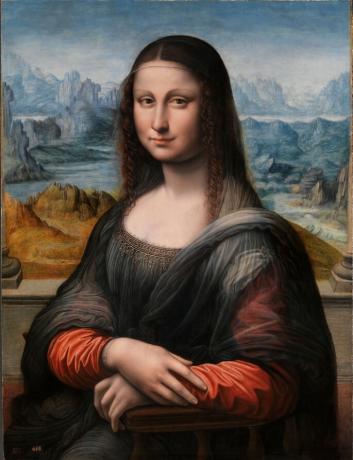
The most accepted theory, because it is collected in Vasari's work, refers that the painting of The Mona Lisa it would have been commissioned by the merchant Francesco del Giocondo. Leonardo would have started to paint it around the year 1503. However, when Vasari describes the work he points out two very important data: he refers to the existence of eyebrows and indicates that the painting was unfinished.
From Leonardo's time there are two more versions of the painting, called Mona Lisa of Ilseworth Y Mona Lisa from the Prado Museum. Of the latter, it is known that it is a copy made in Leonardo's workshop by one of his disciples, probably Andrea Salai. It was made between 1503 and 1519 applying the same technique and material conditions: oil on a wooden board (walnut), measuring 76.3 x 57 cm. Some quality differences are visible, such as the difficulty of the sfumato.
Refering to Mona Lisa of IlseworthFor a long time it was believed that it was a forgery, among other things because it is made on canvas, unlike the one in the Louvre and the Prado. However, recent scientific studies reveal that the pigments and materials are from the same era. Is it a version of Leonardo himself? In fact, will it be the first version of the painting?
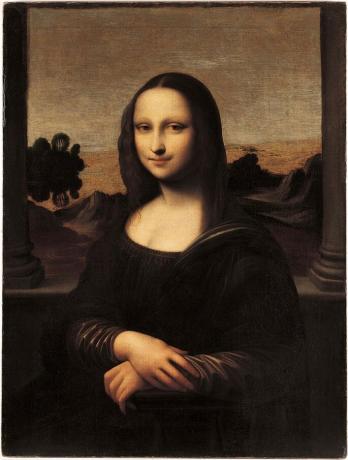
The most obvious differences with the classic Gioconda they are three:
- the woman, whose face has more defined eyebrows, looks younger;
- It is clearly framed between two columns and
- the background landscape is unfinished.
In case it was made by Leonardo, it might make sense that it was a first version, if we consider the youth of the model in comparison with the Mona Lisa in the Louvre and in relation to the years it took for Leonardo to develop the painting. The model appears to be the same.
Faced with this last piece of information, the question arises: is it possible that this painting was a first version of the portrait? Could Leonardo have done both portraits at the same time? Since Vasari speaks of an unfinished Mona Lisa with eyebrows, could he have been referring to this one or the one who guards the Louvre? If Vasari was referring to the one in the Louvre, could it be that the eyebrows of the Gioconda original were accidentally erased during some maintenance or restoration process?
These questions still without satisfactory answer are part of the mysteries surrounding the work that have caught the attention of the world, but... Are they enough to explain the extraordinary phenomenon of diffusion of the painting?
You may also be interested in reading about it:
- Painting The Last Supper by Leonardo da Vinci
- Vitruvian Man, by Leonardo da Vinci
- Works by Leonardo da Vinci
History of the painting Mona Lisa
The Mona Lisa It was made by Leonardo between 1503 and 1519. The most accepted thesis suggests that it is a commission from the cloth merchant Francesco del Giocondo. As was common with the Renaissance painter, Leonardo never finished the painting, so he refused to hand it over and it remained in his possession until the end of his days.
Only after his death, or perhaps shortly before his death, was the painting acquired by King Francis I of France in the middle of the 16th century, who even paid twelve thousand francs for it. After the death of Francisco I, the work was destined to Fontainebleau, soon to Paris and, finally, to Versailles. After the French Revolution, when it was considered part of the French state treasury, it was handed over to the custody of the Louvre Museum in 1797.
It has remained in the Louvre museum until today, except for three interruptions. The first, when Napoleon brought her into his bedroom (from 1800 to 1804). The second, when she was stolen from the museum by Vicenzo Peruggia (from 1911 until her return in 1914). And the third, when she took refuge in the castle of Amboise during the Second World War and, later, in the abbey of Loc-Dieu.
Importance of Gioconda and its influence on art
The genre of the pictorial portrait of personalities, as we know it, took place in the early Renaissance, around the 14th century. It means that by the time Leonardo painted The Mona Lisa there was already a more or less consolidated portraiture tradition, adapted to certain conventions. The most common model before Mona Lisa he focused his attention on the representation of the character up to the middle of the torso, so that the face, head and shoulders covered the entire composition.
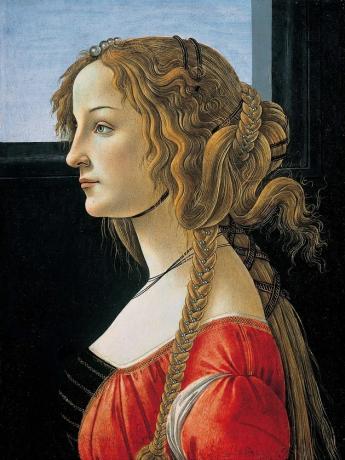
The picture of the Mona Lisa It belongs to the genre of Renaissance portraiture, but the way Leonardo da Vinci painted it differs in some respects from the tradition in which portraits of women were painted at that time. The woman looks directly at the viewer and smiles confidently, two attitudes attributed to aristocratic men rather than women.
In the portrait Mona Lisa Not only the face, head and shoulders are shown, but also the torso below the waist, exposing arms and hands and thus greater expressive possibilities. In this way, Leonardo reveals a lot about the character, something that he would not have managed to follow the previous model.

However, this was not the only portrait made by Leonardo and, furthermore, if we take into account the fact that Leonardo she preserved until the end of her days, her influence in those days was only limited to the small circle of people who achieved see him. In any case, we cannot deny that the impact on that circle was significant, to the point that they left written testimony. For this reason, the painter Rafael studied it and took it as a reference to elaborate the portrait of Maddalena Doni.
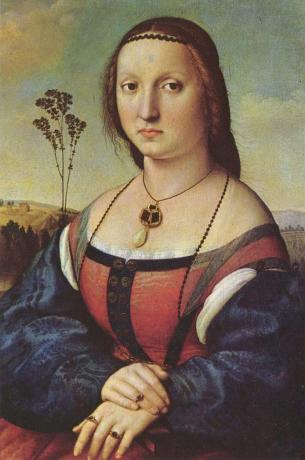
In the original portrait of the Mona Lisa we can see the signs of perfection that Leonardo achieved in the development of the technique of sfumato, and in fact, it is believed that, in the end, this painting was worked by Leonardo while he was painting the famous painting of John the baptist, where he reveals himself as a true master of chiaroscuro. This means that Leonardo's technique would have reached its perfection in these two works. But does its current importance derive solely from its technical excellence?
Impact of theft of The Mona Lisa
It seems that the popularity of the Mona Lisa It is of relatively recent attribution, and was catapulted by the robbery committed by the Italian Vincenzo Peruggia, a former employee of the Louvre Museum, on August 21, 1911. In fact, the theft was only noticed 24 hours later, which means that the piece did not receive special security attention at the time.
Theft of the Mona Lisa It was truly scandalous, both for the surprise of the theft and for the treatment of the investigation, that put under suspicion two great public figures of the moment: the young Guillaume Apollinaire and Pablo Picasso. Apollinaire, in fact, was detained for a week for inquiries. After two years of investigations, the authorities found the whereabouts of Peruggia, who had tried to sell him to Alfredo Geri, then director of the Uffizi Gallery in Florence.

Theft of the Mona Lisa not only put the piece in the sights of the world. It also influenced the assessment of the other versions of the portrait, made by Leonardo or in Leonardo's workshop.
We refer promptly to the aforementioned Mona Lisa of Ilseworth, whose existence was only discovered after the theft. The late appearance of this piece on canvas sowed suspicions about its provenance, since many thought that could have been a forgery made during the time the Louvre was in the hands of Peruggia.
A few years after the return of the piece, now considered by the general public as a treasure, the Dadaist Marcel Duchamp and the surrealist Salvador Dalí would give the final blow to consecrate his fame by making each of them a version irreverent.
In summary, all these issues are part of the context that has influenced the extraordinary diffusion of the work worldwide:
- the existence of several versions of the same motive;
- Leonardo's reluctance to deliver the work;
- the significant economic investment of King Francis I of France to acquire it;
- Napoleon's desire to see her in his rooms;
- the robbery perpetrated by Peruggia and ...
- the irreverent parodies of Duchamp and Dalí.
All this only confirms its validity as a true symbol of Western culture.
It may interest you:
- The 25 most representative paintings of the Renaissance
- Renaissance



